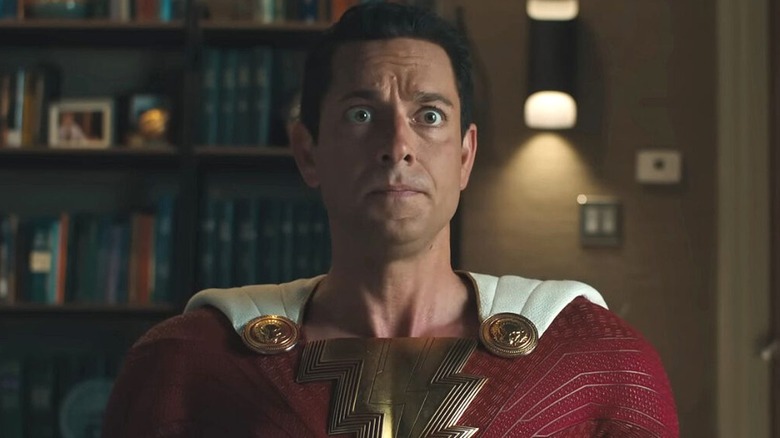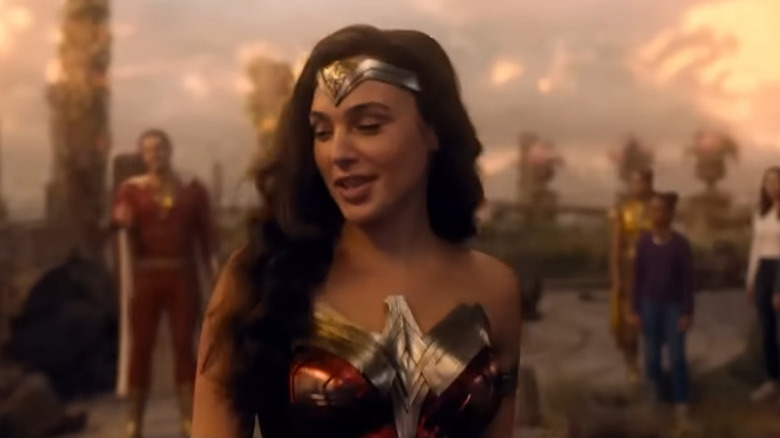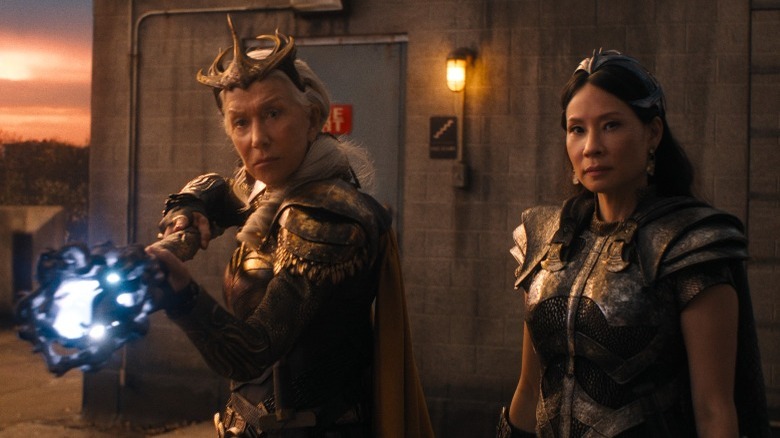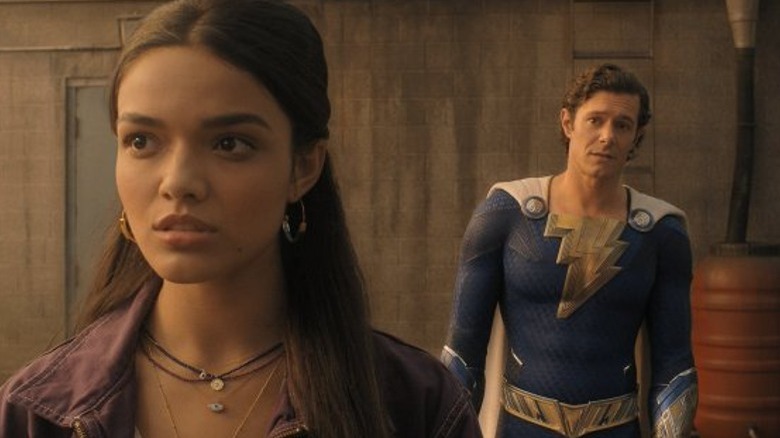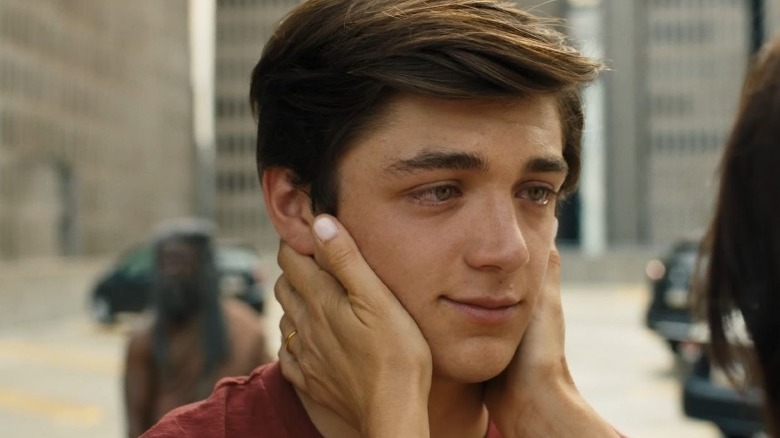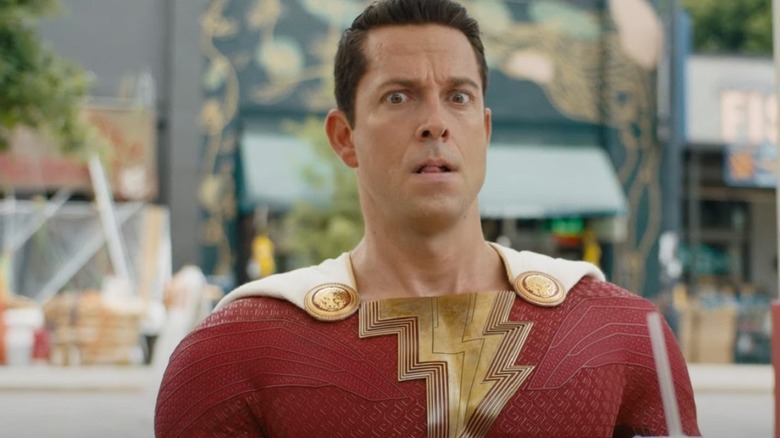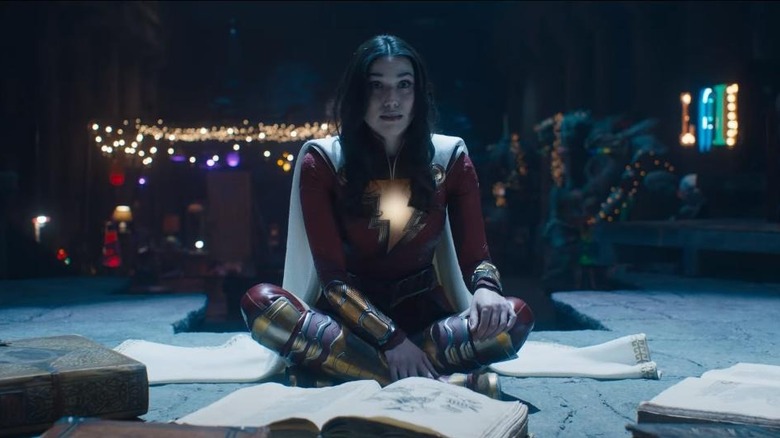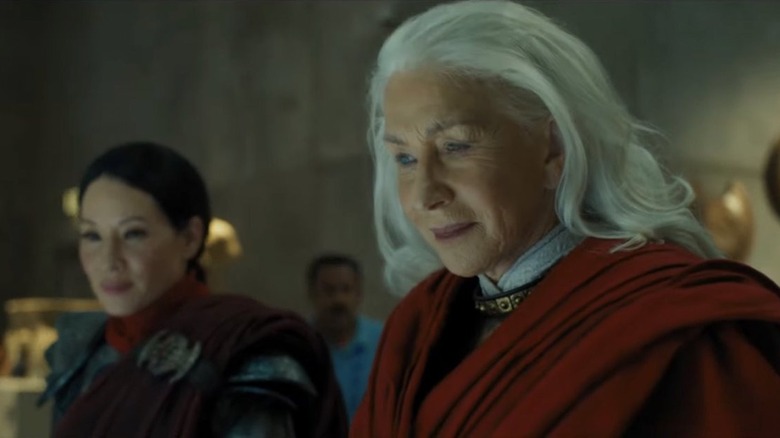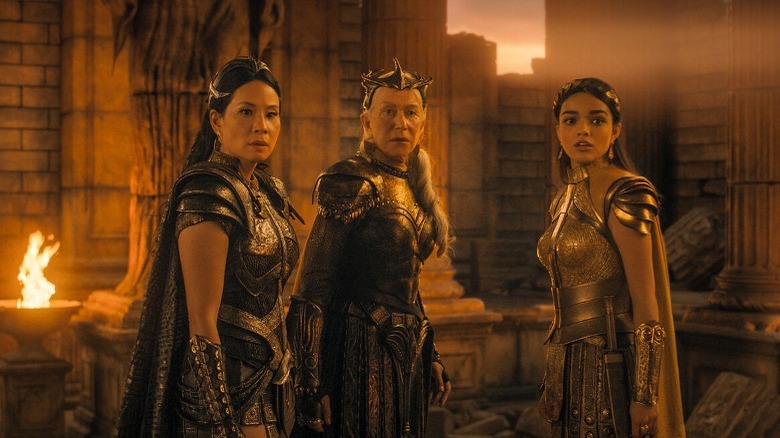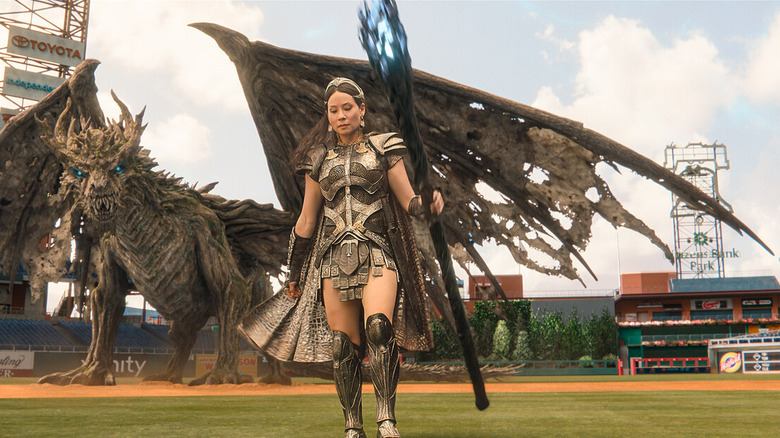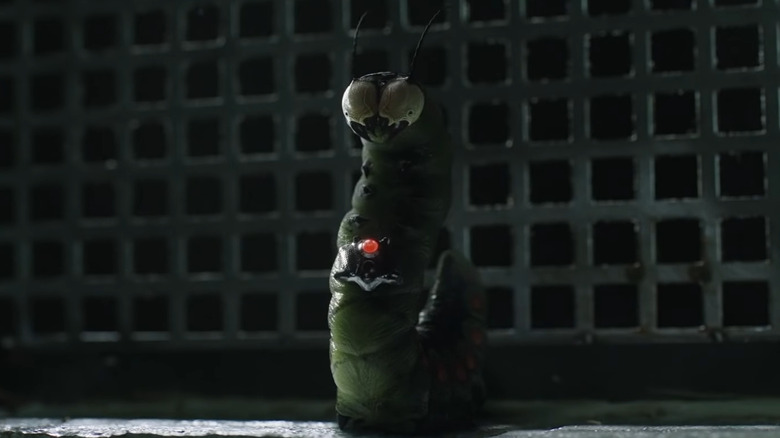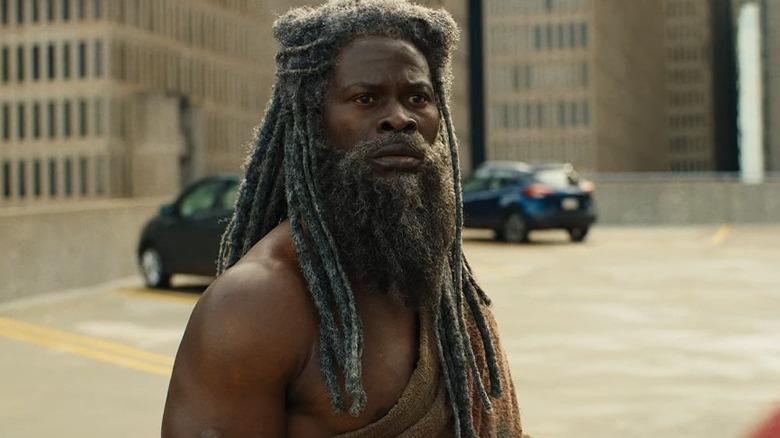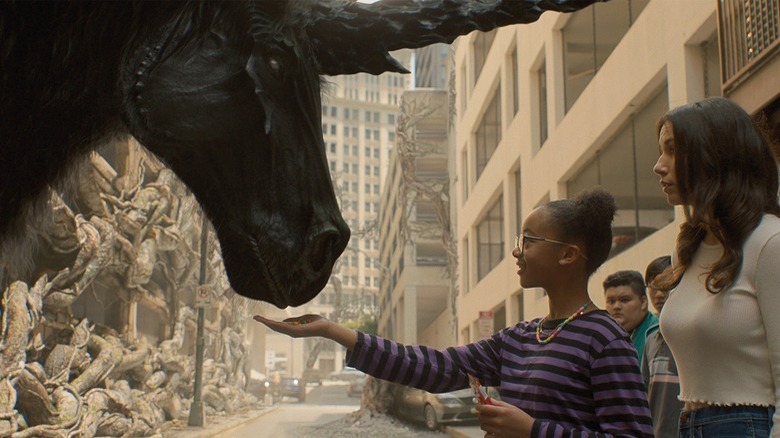Dumb Things We Ignore In Shazam! Fury Of The Gods
Are we finally starting to suffer from superhero fatigue? The reviews for "Ant-Man and the Wasp: Quantumania" suggest that the Marvel Cinematic Universe — fairly consistently well-received up to this point — has perhaps finally reached diminished returns. Meanwhile, the DC Extended Universe — which has a rich but scattered history to put it politely — has delivered a sequel to 2019's "Shazam!" that's also been met with middling reviews, and at least initially disappointed at the box office. "Shazam! Fury of the Gods" comes at a somewhat awkward, transitional time for the DCEU, as new DC Studio heads James Gunn and Peter Safran have grand plans for a reboot — and it's not clear if the "Shazam!" franchise will be a part of it.
"Fury of the Gods" applies the often-seen "spaghetti at the wall" approach, with a breathlessly busy story and so many characters it feels almost like a massive crossover event. Billy Batson — played by Asher Angel as a kid, and Zachary Levi in Shazam form — anchors the movie, but the rest of his now similarly super-powered foster siblings take on expanded roles, and a trio of new villains is introduced. The "Shazam!" movies are a departure from the gloomy, grittier feel of most of the DCEU movies, but that results in some general silliness and tonal strangeness that can be tough to take. These are the dumb things we all ignore in "Shazam! Fury of the Gods."
The Wonder Woman cameo
Marketing is a tricky business. On the one hand, revealing Wonder Woman's (Gal Gadot) appearance in a "Shazam! Fury of the Gods" TV spot got fans excited to see what part she would play in the film. But on the other hand, it may also have raised expectations too high, and fans that went in expecting to see Wonder Woman play any kind of significant role were likely frustrated for most of the movie's runtime. An early dream sequence pointedly avoids showing her face — a reference to the "headless Superman" cameo in the first movie — only to have the Wizard's (Djimon Hounsou) head appear on her body.
As it is, she shows up in the last minutes of the movie, barely speaks, and functions as a quite literal "deus ex machina." Her status as a demigoddess apparently enables her — with no visible effort — to restore power to the Wizard's staff, re-invigorate the entire Realm of the Gods, and even bring Billy back to life. Her key role in turning a bleak ending into a happy one hasn't been foreshadowed or built up to at all, so for any audience members who didn't have her presence spoiled by the TV spots it just seems random and hastily done. All this so we can have an extended beat of Zachary Levi painfully attempting to flirt as a 17-year-old boy would, means the payoff certainly isn't worth the wait.
It takes an axe to mythology
The existence, motivations, and methods of the Daughters of Atlas — the primary villains in "Shazam! Fury of the Gods" — are confusing in almost every respect. While it's not as if the MCU's "Thor" movies are entirely faithful to the original Norse myths that they're drawn from, they at least make the metaphysics and lore of their own story clear and have occasional deep-cut references that imply a reverence for the mythos. "Fury of the Gods," by contrast feels like it lightly skimmed some Greek myths, and brings very little authenticity other than an opening scene filmed in Athens' New Acropolis Museum.
Hespera (Helen Mirren), Kalypso (Lucy Liu), and Anthea (Rachel Zegler) appear to be very loosely inspired by the Hesperides — wood nymph daughters of Atlas that indeed guarded a tree bearing golden apples. But in the original myths, they have different names, aren't warriors whatsoever, and — like many other triumvirates of mythological women — they didn't seek to play a role in human affairs. "Shazam! Fury of the Gods" invents its own story entirely but explains it so hastily and lazily that it hardly lives up to its mythical roots.
The absurdly extreme age gaps
In an over-crowded screenplay, the only storyline in "Shazam! Fury of the Gods" that really gets any time to breathe is the budding romance between Freddy (Jack Dylan Grazer and Adam Brody) and a new classmate named Ann. We learn that Ann — despite appearing to also be a teenager — is actually Anthea, a Daughter of Atlas and a goddess that is thousands of years old. Even though it is mentioned definitively that Freddy is not yet eighteen, this romance is still something that lingers for the rest of the movie, and it ultimately motivates Anthea to turn on her sisters and help save humanity.
The movie attempts to have its cake and eat it too when Freddy's foster father Victor (Cooper Andrews) makes a joke about how both Freddy and Billy seem to have a thing for older women — this after Billy failed to flirt with the similarly ageless Wonder Woman. But calling out the inappropriateness of a multi-millennia age gap doesn't really make it less creepy on the face of it. And Freddy's parents are apparently happy for Freddy — who has presumably just turned eighteen by the closing scenes of the movie — to keep dating an older woman ... literally older than civilization itself.
We never see the main character
In the first "Shazam!" in 2019, the dual performances of Asher Angel and Zachary Levi as Billy carry the film. "Shazam! Fury of the Gods," however, has us spend the vast majority of the movie with Levi's histrionic, goofy superhero version of the character, and relegates Asher Angel to just a handful of scenes. The expanded focus on the rest of his Shazam family (or "Shazamily") and the overabundance of constant peril leave little time for much else so it is understandable in that respect. Almost as an afterthought, "Fury of the Gods" still tries to work in a subplot about Billy's anxiety about turning eighteen and having to leave home.
While Angel and Marta Milans — who plays Billy's foster mother Rosa — give it their all in a scene near the end, the drama would land better if we'd been able to spend any time with Billy in regular human form when he is processing his emotions prior to this. Rosa has to actually lampshade the issue directly and ask to see "my Billy" for just a moment before he heads off to the climactic fight with Kalypso. Without Angel's performance to ground the character in reality, Levi's constant bouncing off the walls gets a little tiresome by the end of the film.
Shazam is an acronym?
Granted, this isn't an invention of the movie, but in "Shazam! Fury of the Gods" we learn that the magic word "Shazam!" is in fact an acronym that explains the powers that the Wizard granted Billy. It is drawn from the names of six mythical figures: Solomon (wisdom), Hercules (strength), Atlas (stamina), Zeus (power), Achilles (courage), and Mercury (speed). While it's kind of neat to learn the origin of the term itself, the explanation pulls a lot of logistical threads that unravel the logic of the "Shazam!" universe along with it.
Why would an ancient, magical acronym that dates back to Ancient Greek gods be in English? Why wouldn't Zeus, the king of all the gods, be the first one in the order? How did Athena, the Greek goddess of wisdom, lose out to King Solomon, a Biblical figure that doesn't really fit with the other five gods or demigods on the list? And if Billy, in Shazam form, has the Wisdom of Solomon why is he generally prone to consistently saying and doing pretty comically dumb stuff? It's a detail that prompts more questions than answers, and few of them make any sense at all.
Mary doesn't have a doppelganger
A small but perniciously confusing detail in "Shazam! Fury of the Gods" is that Mary is played in both regular and Shazam form by the same actress, Grace Caroline Currey. In the previous "Shazam!" movie, the superheroine part was played by Michelle Borth. So in addition to keeping track of the combined ten actors that play the other five siblings, audiences have to put together that Mary is only changing outfits when the living lightning strikes, and wonder if there's an explanation in the story.
It's possible that since Mary has turned eighteen in between movies, she no longer gets an "adult" doppelganger form after transforming. Does this mean that Freddy and Billy, also about to turn eighteen, will lose their significantly more muscular alter egos as well? But it doesn't make sense that magical spells would be tied to the legal voting age in modern-day America. With some of the other siblings looking absolutely nothing like their adult counterparts, Mary's singular existence is a confounding, confusing riddle.
Hespera was right
Hespera is one of the bad guys in movies that's actually right, and it's hard not to be compelled by her eloquent tirade to Billy when they meet to negotiate. After all, the life force of her mother, the stamina of her Titan father, and the powers of the gods have all been given to some relatively incompetent children. It would be more sympathetic if she and Kalypso hadn't opened the movie by casually turning several innocent people into stone, but she's not wrong that godlike powers have been mostly wasted on Billy's family, whom the local press refers to as the "Philadelphia Fiascos."
If they had been more civil about asking, it would actually be eminently reasonable just to ask for the powers back in exchange for returning to the Realm of the Gods and leaving humanity unharmed. And Kalypso obviously doesn't help by escalating things so extremely with the golden apple. But Helen Mirren, clearly the member of the cast having the most fun, really makes you feel Hespera's long-simmering pride and resentment over being trapped in a dying realm, and it's easy to temporarily take her side. Perhaps in a superhero film, it shouldn't be this easy to take sides with the villain, but Hespera makes a compelling case.
Three sisters that look nothing alike
Not to pry into a family's business, but it really feels like the Daughters of Atlas should do a DNA test and see what's going on with their lineage. As much fun as Helen Mirren, Lucy Liu, and Rachel Zegler are in the roles, casting three actresses of different generations and completely different racial backgrounds as sisters is kind of distracting. It gives a distinct impression of randomness as if the movie were cast by spinning a wheel.
They're all presumably a similar six thousand years in age, so why does Anthea look young enough to be in high school? "Fury of the Gods" is clearly relatively proud of itself for the plot twist that Ann turns out to be the third daughter of Atlas, but how were we supposed to have guessed she's even related to Hespera and Kalypso? And despite thousands of years to plot their revenge, the sisters are also on three entirely different pages in terms of motivation: Anthea wants to leave humanity in peace, but Kalypso to enslave them. Ultimately the Daughters of Atlas seem more like a hastily assembled trio of strangers, making it hard to either empathize with them or take them seriously as a threat.
Why was the golden apple in the Rock of Eternity?
Somehow "Shazam! Fury of the Gods" doesn't explain to either us the audience or to Billy and his siblings the importance of the apple-shaped paperweight in the library until it's too late. Hespera, after purposefully letting herself be captured, breaks out of her cell in the Rock of Eternity and steals the apple, revealing the formerly-black object to in fact be a golden apple from their realm — one that contains the all-important Seed of Life. So how did it get to the Rock of Eternity in the first place, and why was it just laying around?
The apple is part of a pattern in the "Fury of the Gods" where the story lurches from place to place, revealing key information after the fact. It turns out Billy breaking the staff in the first movie, is what broke the seal preventing gods from entering the mortal realm — although why the Daughters of Atlas waited three years to do so isn't explained. Let's hope the violin that's always on fire doesn't turn out to be the key to keeping some other enemy at bay.
The pointless post-credits scene
There's a fun element of art deco cartoonishness that defines the history of DC comics — a spirit that lends itself well to animation and that the bright, silly vibe of the "Shazam!" movies captures well. But it's a bit frustrating for "Fury of the Gods" to end with a post-credits scene that is essentially a re-run of one of the credits scenes from the first movie. Villain Dr. Thaddeus Silvana (Mark Strong) is still drawing symbols on his prison cell walls and is once again visited by a talking alien worm that DC fanatics recognize as Mr. Mind.
The idea of Mr. Mind actually getting a story arc, as teased by the first movie, is delightful. Instead of the constant, CGI-laden brutal smackdown fights that dominate most superhero movies, we'd get to see Billy matching wits with a little talking worm with silly eyes and a robot voice. But clearly, the franchise is only interested in joking about the idea during the credits instead of actually committing to it. With the trajectory of the DCEU shifting and the fate of a third "Shazam!" movie in doubt, it seems Mr. Mind will never get his proper due.
It runs the name jokes into the ground
What's in a name? According to "Shazam! Fury of the Gods," names are an endless source of humor and a well that can be returned to time and time again to the exhaustion of the audience. The movie has a running gag about how neither Billy nor his siblings have proper "superhero names" like their more famous counterparts Superman or Wonder Woman. They're collectively called the "Philly Fiascos" in the press because of constant collateral damage, and no one other than Freddy ("Mr. Everypower") seems to have given thought to an individual codename.
Because that apparently wasn't enough name humor, "Fury of the Gods" has the Wizard constantly misremembering Freddy's name when they're trapped together in the prison. Freddy seems a little too offended, considering he and the Wizard have in fact just met, but then the movie's epilogue reveals that the Wizard was actually doing it on purpose. One of the movie's most self-serious and mystical characters had to get in on the constant quipping — he must have felt left out, not having a proper name of his own beyond "The Wizard" or "Shazam."
The Skittles commercial
There's product placement in movies, there are winking and ironic references to pop culture, and somewhere in the confusing and horribly jarring middle ground, there's the full-on commercial for Skittles candy that pops up in "Shazam! Fury of the Gods." When the magical tree releases a bunch of angry, mythical creatures on Philadelphia, we're told that all the other monsters fear unicorns, the fiercest creature of them all. Based on the also hastily-learned factoid that unicorns enjoy sweet treats, Darla (played by Faithe Herman and Megan Good) figures out she can tame them with the help of a familiar convenience store treat.
Darla's affinity for both unicorns and Skittles had already been established, so the plot point is silly but not altogether unearned by the movie. What truly shatters the fourth wall, however, is when Darla whispers "taste the rainbow" in the same inflection as in many Skittles commercials themselves — a note so shamelessly corporate that you might think that movie theaters have started selling mid-movie ad time. Imagine if during "E.T. the Extra-Terrestrial", the alien turned to the camera and said "There's no wrong way to eat a Reese's!"
